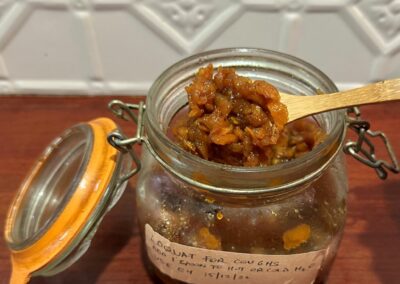Loquat, Eriobotrya japonica







Cultivation notes
Evergreen rounded tree 3-10 m high and 3-8 m wide. Can be pruned to contain size. Thrives in most parts of Australia, grows easily from seed but fruit quality and size is unpredictable so grafted trees are best. Tolerant of drought and some frost once established with good fire-retardant properties.
Purchase grafted trees from your local reputable nursery.
Uses
Fruits are often ignored due to large seeds, but are valuable as the earliest stone fruit, when few fruits are in home gardens. Eat fresh, stewed whole or cut in half and de-stoned first. Pair well with vanilla, cinnamon stick, star anise. Remove seeds before dehydrating. Use seeds to make Nespolino liqueur. Leaves used for medicinal herbal tea. Trees are overstorey plants in permaculture gardens.
Recipe
Loquat Liqueur Nespolino uses the seeds!
Soak 40 seeds in 500ml of 60% proof alcohol for 1 month, decant and add 500ml water and 200gm sugar. Leave for 1 month, serve from the freezer. (‘Preserving the Italian Way’ by Pietro Demaio)
Loquats are the earliest stone fruits, filling a gap in the fruiting calendar at this time of year where few other fruits can. Despite this they are often ignored and thought of as fruit not worth defending or harvesting, mostly due to their large seeds and only small amounts of mild peachy tasting fruit. Most loquats grow into the big evergreen trees common in many southern suburban gardens from self-seeded plants, so have very variable fruits. However there are a range of grafted varieties that may change your opinion, producing loquats with a large fruit to seed ratio, and with better flavour than many backyard trees. Look out for Bessel Brown, although this variety may produce only every second year, or Herd’s Mammoth, and Australian variety which tastes best when picked quite ripe., see video below
Video
- We hope our signs are just the beginning, for more understanding, contact a local elder in your area.



